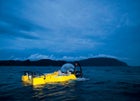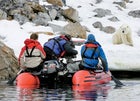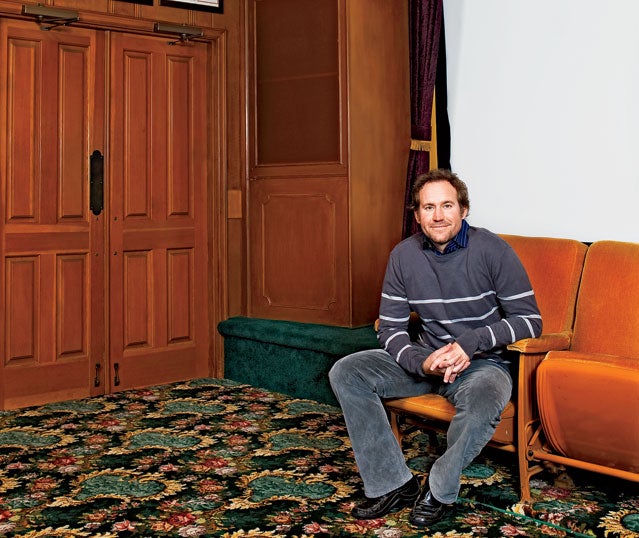When you think of film producers whose movies have grossed $1 billion, the usual suspects come to mind: James Cameron, Ron Howard, Jerry Bruckheimer. Add to that list a humble surfer dude from Southern California named Greg MacGillivray. In 1963, MacGillivray cofounded the documentary studio MacGillivray Freeman Films. Since then, Laguna Beach–based MFF has made 35 large-format features, including and , which has been running at the Smithsonian for 36 years. Today, Greg’s 32-year-old son, Shaun, is carrying the Imax banner as MFF’s producer and managing director. In 2010, Shaun helped launch , an environmental campaign using the power of film to inspire people to protect the seas. The project’s first Imax film, , premiered in April. Walker recently caught up with Shaun in Laguna Beach, just after the filmmaker returned from an underwater shoot off Costa Rica’s remote Cocos Island, to talk about the future of Imax and hear the stories behind some of MFF’s most exotic shoots.
submersible, Cocos Island, Costa Rica
 The DeepSee submersible, Cocos Island, Costa Rica
The DeepSee submersible, Cocos Island, Costa Ricasubmersible, hammerhead sharks
 Viewing hammerhead sharks from the submersible
Viewing hammerhead sharks from the submersibleSvalbard
 Shooting in Svalbard for To the Arctic 3D
Shooting in Svalbard for To the Arctic 3DHow was Costa Rica?
Amazing. Cocos Island is a marine reserve in the Pacific, 340 miles off the coast. I shot from a submarine for the first time, and the film crew went down more than 1,000 feet. Most people don’t realize it, but that’s where most underwater life exists. Occasionally, a ragged-tooth shark, hammerhead, or manta ray would dart through, but the most amazing thing was these brilliant flashes of bioluminescence that would light up every 20 minutes or so like fireworks displays.
Tips on shooting below 1,000 feet?
Don’t drink coffee before going in a sub.
You’ve worked in all kinds of environments. Why the massive commitment to ocean filmmaking and conservation?
The ocean sustains all life as we know it. It produces more oxygen than all the rainforests combined.
One World One Ocean is billed as a 20-year effort. That’s a long haul.
A lot of ocean campaigns last six months or a year, and then everyone forgets about it. We want to do something people can’t ignore. In the next five years, we’re making three Imax films, a feature film, an eight-part television series, and hundreds of online segments. We’re investing $10 million ourselves, and profits go toward ocean-focused educational grants, conservation, and fellowships. We’re going to be slammed, but that’s what we want.
Your dad towed you around the world while making films. What’s your first memory from a set?
I was three, and my dad was shooting a scene with a trained tiger in Northern California. When the cat saw me, he got this look in his eyes. He wanted to eat me. The trainer saw what was happening, so he screamed at someone to lock me in the car. I don’t know if I was more upset about nearly being eaten or missing out on the scene.
Why do you guys shoot everything in Imax? It’s such a challenging format.
It’s a love-hate relationship. Imax cameras are by far the best way to capture images for the giant screen. But they shoot only three minutes of film at a time, they take 15 minutes to reload, and they weigh 400 pounds. An Imax film costs $1,000 a minute. Every time you press the record button, it’s hundreds of dollars. This isn’t conventional wildlife filmmaking, where you press record and see what happens. You learn to anticipate, or you lose a lot of money.
I’m guessing you’ve seen some pretty scary FedEx bills.
Seriously. You ever ship 5,000 pounds of film equipment to the Arctic? Twenty-five grand. That’s just for one shoot.
What’s the average production cost of one of your movies?
Ten million dollars.
How long does it take to get the footage you need?
It depends. In the Arctic, we’d spend ten hours filming caribou from the air and be lucky to get 15 minutes of footage, of which we’d use 20 seconds.
Then comes the editing. When do you know you’ve got it right?
We’ll test 20 different rough cuts with audiences before we settle on a final cut. Telling a good story is an art and a science.
You spent eight months shooting To the Arctic. What’s most memorable?
Trailing a polar bear and her two cubs for five days. She fended off four attacks from males who wanted to eat her cubs. Being a mother is a tough job. We also spent four weeks on a boat in Svalbard with 11 guys, a broken water filter, and no showers. Your nose can get used to anything. Except walruses. They are the worst-smelling animals on the planet.
Any close calls up there?
One of the most difficult things about the cold is filming under ice. It was so cold the regulators froze. Our cameramen would be 100 feet from the hole with no air, carrying an Imax camera.
Then you sent them down to film swimming polar bears?
Yeah, but we never saw the polar bears dive below seven feet. We felt like the crew were pretty safe if they were below that. But I’d never do it.
Your movies are in places like museums and aquariums instead of multiplexes. That’s a curious distribution model for a studio that’s generated $1 billion.
In a museum, most of our films enjoy a run of six months to years. To Fly is still playing at the , and it came out in 1976. It plays every half hour, every day. When one of our movies goes into a multiplex, it runs for three weeks.
So no urge to go to Hollywood?
No. A $10 million documentary can change people in ways that a $300 million blockbuster can’t. That’s why I get out of bed every day.
What’s the best thing you’ve learned from your father?
Quality, quality, quality. Keep working at it until it’s the best it can be.
You’re married, with a 14-month-old son. How do you balance filmmaking with family life?
It’s constant evaluating and compromising. I want to be a really good dad, but I also have to be on location when it’s a major priority. Growing up, I loved being on location with my dad. I really want to be able to share that with my family.
Minus the tiger?
Definitely minus the tiger.


